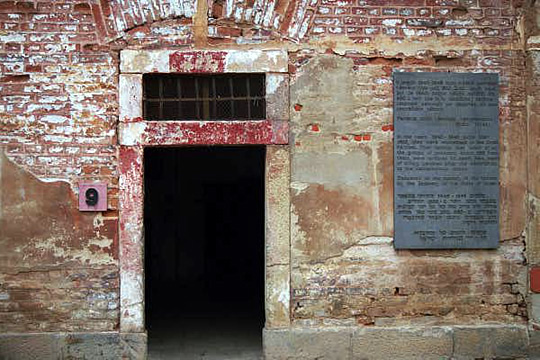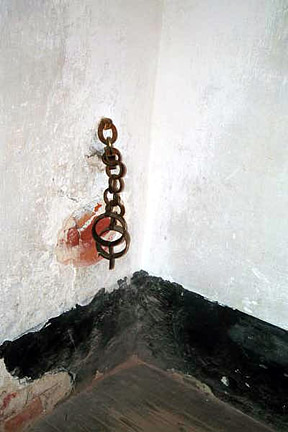First Courtyard in the Small
Fortress
 Solitary confinement
cells were rooms inside the ramparts surrounding the fortress
Solitary confinement
cells were rooms inside the ramparts surrounding the fortress
The First Courtyard of the Small Fortress
at Theresienstadt, which is shown in the photograph above, was
divided into Blocks A and B. There were 17 group cells and 20
small cells for solitary confinement. Up to 1,500 prisoners used
this small courtyard as their exercise yard. According to the
visitor's pamphlet that we were given, the group cells held up
to 100 prisoners at one time. Cell number 1 was reserved for
prisoners from the Soviet Union. Cells number 2 and number 3
were used to imprison Jews who were "arrested for political
activities and violating anti-Jewish regulations."
Notice that the photograph above shows
grass growing on the roof. The prison cells were rooms between
the double walls around the fort, and the roof was covered with
dirt. The whole town of Terezin and the Small Fortress both have
overhead power lines, as you can see in the photograph above.
At the west end of the First Courtyard is where the "shaving
room" was located. This room was remodeled for the Red Cross
inspection in the spring of 1944 when the Nazis went all out
to impress the inspectors for propaganda purposes.
The photograph below shows the door to
one of the group cells in the First Courtyard. This location
is number 9 on the map of the
fortress and the photograph above is number 12 on the map.
The Plaque, which is written in Czech, English and Hebrew, reads
as follows:
In the years 1940 to 1945 more than
1500 Jews were imprisoned in the Small Fortress. Their destiny
was worst of all the groups of prisoners. About 800 from them
were tortured to death here, most of others perished after the
deportation to concentration camps. Dedicated to the memory of
the victims by the Embassy of the State of Israel.

Plaque erected by Israeli
Embassy in honor of 1,500 Jewish prisoners
One of the most famous prisoners to occupy
a cell in the Small Fortress was Gavrilo Princip who was imprisoned
in the First Courtyard after he assassinated Crown Prince Franz
Ferdinand of Austria in 1914. It was this act that led to World
War I. Our tour guide told us that Princip was only 17 years
old and could not be executed because he was underage. We were
also told that Princip is regarded as a hero in the Czech Republic
since it was because of World War I that the Czech people finally
gained independence from the Austrians, which they had been trying
to achieve since 1620. That was the year that the Austrians defeated
the Czechs in the Battle of White Mountain and then executed
27 noblemen of the Czech aristocracy.

Gavrilo Princip was
chained to the wall of his cell
At the end of the First Courtyard is
the entrance to the shower room. The guide told us that this
shower was real, but he said that it was just like the fake shower
rooms which were used as gas chambers. The room has three rows
of pipes suspended from the ceiling but the shower heads are
gone. We were also told that the shower room was used for cleaning
the clothing with hot steam, which killed the lice. This was
done to prevent typhus, a disease which is caused by lice. There
was an undressing room next to the shower room, just like at
Dachau where the shower room was really a gas chamber.
|